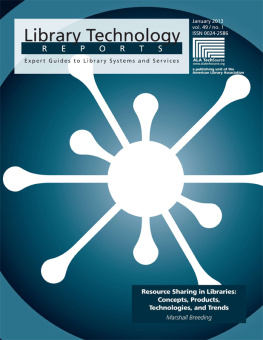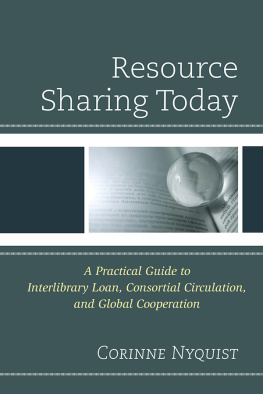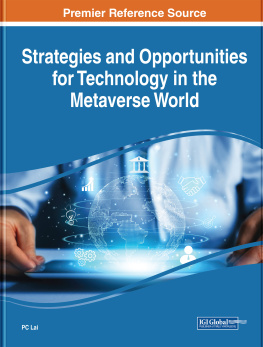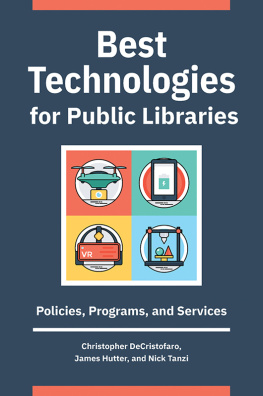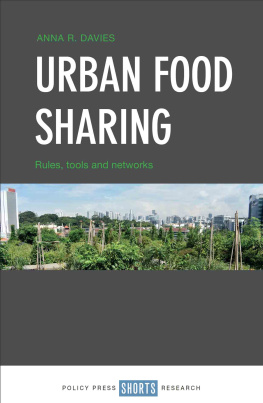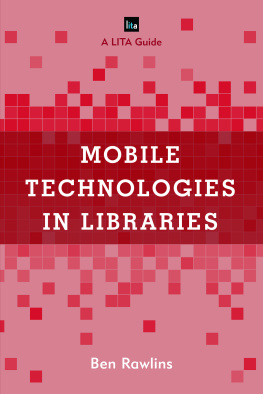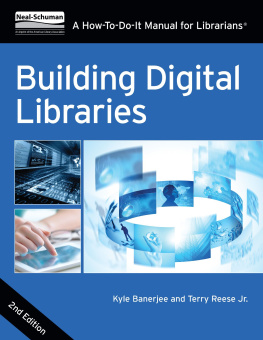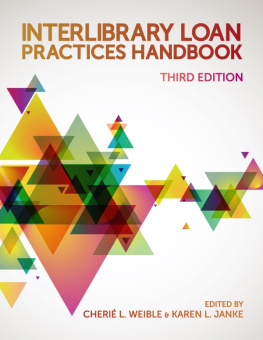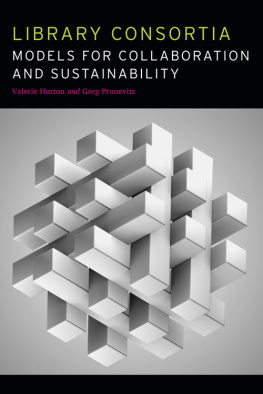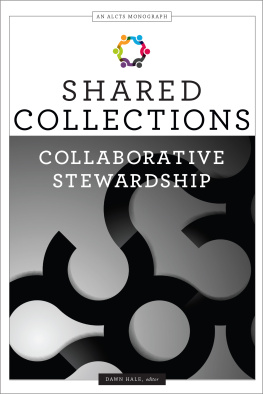
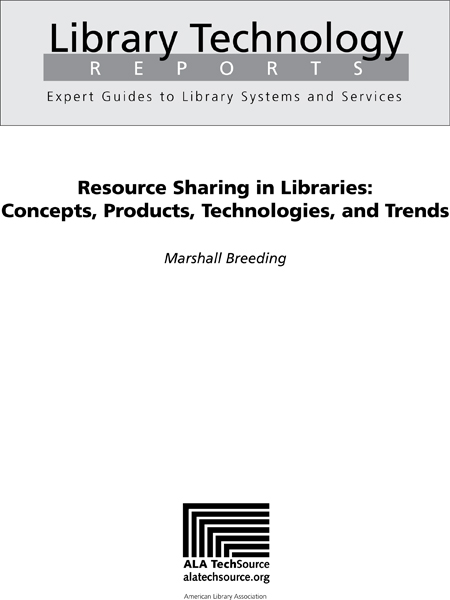
Library Technology Reports
ALA TechSource purchases fund advocacy, awareness, and accreditation programs for library professionals worldwide.
Volume 49, Number 1
Resource Sharing in Libraries: Concepts, Products, Technologies, and Trends
ISBNs: (print) 978-0-8389-5880-3; (PDF) 978-0-8389-5881-0; (ePub) 978-0-8389-5882-7; (Kindle) 978-0-8389-5883-4.
American Library Association
50 East Huron St.
Chicago, IL 60611-2795 USA
alatechsource.org
800-545-2433, ext. 4299
312-944-6780
312-280-5275 (fax)
Advertising Representative
Patrick Hogan
312-280-3240
Editor
Patrick Hogan
312-280-3240
Copy Editor
Judith Lauber
Production and Design
Tim Clifford, Production Editor
Karen Sheets de Gracia, Manager of Design and Composition
Library Technology Reports (ISSN 0024-2586) is published eight times a year (January, March, April, June, July, September, October, and December) by American Library Association, 50 E. Huron St., Chicago, IL 60611. It is managed by ALA TechSource, a unit of the publishing department of ALA. Periodical postage paid at Chicago, Illinois, and at additional mailing offices. POSTMASTER: Send address changes to Library Technology Reports, 50 E. Huron St., Chicago, IL 60611.
Trademarked names appear in the text of this journal. Rather than identify or insert a trademark symbol at the appearance of each name, the authors and the American Library Association state that the names are used for editorial purposes exclusively, to the ultimate benefit of the owners of the trademarks. There is absolutely no intention of infringement on the rights of the trademark owners.

alatechsource.org
Copyright 2013 Marshall Breeding
All Rights Reserved.
About the Author
Marshall Breeding is an independent consultant, speaker, and author. He is the creator and editor of Library Technology Guides (www.librarytechnology.org), a columnist for Computers in Libraries, and the editor of Smart Libraries. He has authored the annual Automation Marketplace feature published by Library Journal since 2002. Marshall has also edited or authored seven books, including Cloud Computing for Libraries, published in 2012. Formerly the director for innovative technology and research for the Vanderbilt University Library, he regularly teaches workshops and gives presentations internationally at library conferences. This is his tenth issue of Library Technology Reports.
Abstract
Library Technology Reports (vol. 49, no. 1) Resource Sharing in Libraries: Concepts, Products, Technologies, and Trends provides information on the resource-sharing alternatives available today, explores some of the relevant technology trends underway, and looks at the evolving strategies emerging as libraries continue to seek innovative ways to provide more resources to their patrons despite the realities of reduced staff and collection budgets. It reviews the major products that provide interlibrary loan and resource-sharing services and that automate interlibrary loan operations.
Get Your Library Technology Reports Online!
Subscribers to ALA TechSources Library Technology Reports can read digital versions, in PDF and HTML formats, through the scholarly content host MetaPress. Subscribers also have access to an archive of past issues. Visit , if you have any questions about or problems with access.
Subscriptions
alatechsource.org/subscribe
Contents
Introduction to Resource Sharing
Abstract
Chapter 1 of Library Technology Reports (vol. 49, no. 1) Resource Sharing in Libraries: Concepts, Products, Technologies, and Trends presents some of the conceptual approaches available to libraries in the way that they provide access to materials to their patrons beyond their local collections. Models of resource sharing discussed include sharing an integrated library system among the members of a regional consortium; implementing a resource sharing environment to connect ILS implementations to enable consortial borrowing; and providing materials through document delivery services or global interlibrary loan systems.
N o library today can be expected to directly hold all of the resources to fulfill all the needs of its users. Rather, most libraries supplement their local collections through resource-sharing arrangements that allow them to offer their clientele access to a broader universe of materials. Libraries participate in local, regional, or global services for the borrowing and lending of materials, supported by different types of organizational relationships and technical infrastructure.
This issue of Library Technology Reports provides information on the resource-sharing alternatives available today, explores some of the relevant technology trends underway, and looks at the evolving strategies emerging as libraries continue to seek innovative ways to provide more resources to their patrons despite the realities of reduced staff and collection budgets. It reviews the major products that provide interlibrary loan and resource sharing and that automate interlibrary loan operations.
In these times when libraries experience harsh budgetary limitations, they need to exploit every possible opportunity to achieve better services for their patrons with fewer resources. Interlibrary loan, consortial borrowing, document delivery, and shared collections are some of the key strategies that allow libraries to provide access to more materials than are available in their local collections. Books involve the fulfillment of a physical object that must be returned to its original owing institution; articles, book chapters, and other content items of manageable length can be scanned for electronic delivery. Different types of technical infrastructure are needed to support each of these models of resource sharing. Material type plays a major role in resource-sharing options.
Many different models are found within the realm of resource sharing. We will consider global interlibrary loan services such as OCLCs WorldCat Resource Sharing service, as well as systems that facilitate cooperative reciprocal lending among consortia or regional library systems to more effectively pool and share their collections.
The key principle of resource sharing centers on enabling libraries to provide access for their patrons to materials beyond their immediate local collection. Some involve reciprocal agreements where libraries make some or all of their collections available on request to patrons affiliated with cooperative partner institutions; others, where libraries or other organizations supply materials for a fee.
Technology plays an essential role in support of resource sharing. Libraries depend on various types of automation systems to manage their collections, and other layers of infrastructure are needed to enable broader exchange of resources among libraries and their patrons. Some of the important areas that we will examine include staff workflow tools that help personnel in a library manage requests and fulfillments from external systems, system-to-system communications that allow integrated systems to interact with resource-sharing environments, supporting standards or protocols, and other technology or infrastructure components. We will consider some of the models of resource sharing, ranging from circulation of materials within a single library system, to consortial borrowing environments created among libraries with independent integrated library system implementations, to centralized interlibrary loan services, to shared infrastructure in support of automation and resource sharing.
Next page
